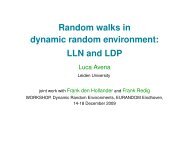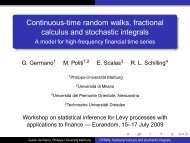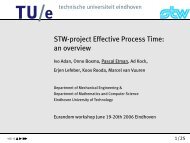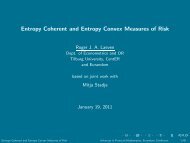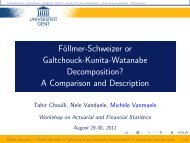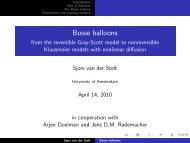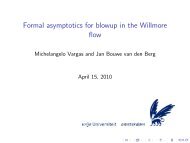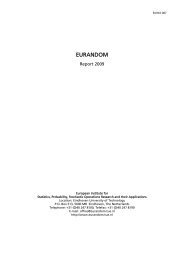Hamzi - Eurandom
Hamzi - Eurandom
Hamzi - Eurandom
You also want an ePaper? Increase the reach of your titles
YUMPU automatically turns print PDFs into web optimized ePapers that Google loves.
Preliminary Results on<br />
Control and Random Dynamical Systems in<br />
Reproducing Kernel Hilbert Spaces<br />
Boumediene <strong>Hamzi</strong>,<br />
Department of Mathematics,<br />
Imperial College, London, UK.<br />
email: b.hamzi@imperial.ac.uk<br />
joint work with Jake Bouvrie (Duke University)<br />
. . . . . .<br />
Boumediene <strong>Hamzi</strong> (Imperial College) On Control and RDS in RKHS June 4th, 2012 1 / 55
Context<br />
Goal: Combining tools from the theories of Dynamical Systems and<br />
Learning in view of analyzing, predicting and controling nonlinear systems<br />
on the basis of data rather than models.<br />
Approach: View Reproducing Kernel Hilbert Spaces as “Linearizing<br />
Spaces”, i.e. Nonlinear Systems will be mapped into an RKHS where<br />
Linear Systems Theory will be applied.<br />
. . . . . .<br />
Boumediene <strong>Hamzi</strong> (Imperial College) On Control and RDS in RKHS June 4th, 2012 2 / 55
Outline<br />
• Review of Some Concepts for Linear Control Systems<br />
• Elements of Learning Theory<br />
• On Nonlinear Control Systems in RKHS<br />
• Application: Model Reduction of Nonlinear Control Systems in RKHS<br />
• Review of Some Concepts for Linear SDEs<br />
• On Nonlinear SDEs in RKHSes<br />
• Application: Estimation of the Stationary Solution of the Fokker-Planck<br />
Equation of nonlinear SDEs<br />
• Application: Parameter Estimation of SDEs in RKHSes<br />
. . . . . .<br />
Boumediene <strong>Hamzi</strong> (Imperial College) On Control and RDS in RKHS June 4th, 2012 3 / 55
Review of Some Concepts for Linear Control Systems<br />
• Consider a linear control system<br />
˙x = Ax + Bu<br />
y = Cx<br />
where x ∈ R n , u ∈ R q , y ∈ R p , (A, B) is controllable, (A, C) is observable<br />
and A is Hurwitz.<br />
• We define the controllability and the observability Gramians as,<br />
respectively, Wc = ∫ ∞<br />
0 eAtBB⊤e A⊤t dt, Wo = ∫ ∞<br />
0 eA⊤ tC⊤Ce At dt.<br />
• These two matrices can be viewed as a measure of the controllability<br />
and the observability of the system.<br />
,<br />
. . . . . .<br />
Boumediene <strong>Hamzi</strong> (Imperial College) On Control and RDS in RKHS June 4th, 2012 4 / 55
Review of Some Concepts for Linear Control Systems<br />
• Consider the past energy, Lc(x0), defined as the minimal energy required<br />
to reach x0 from 0 in infinite time<br />
∫ 0 1<br />
Lc(x0) = inf<br />
∥u(t)∥<br />
u∈L2(−∞,0), 2 −∞<br />
x(−∞)=0,x(0)=x0<br />
2 dt.<br />
• Consider the future energy, Lo(x0), defined as the output energy<br />
generated by releasing the system from its initial state x(t0) = x0, and<br />
zero input u(t) = 0 for t ≥ 0, i.e.<br />
Lo(x0) = 1<br />
2<br />
for x(t0) = x0 and u(t) = 0, t ≥ 0.<br />
∫ ∞<br />
∥y(t)∥ 2 dt,<br />
0<br />
. . . . . .<br />
Boumediene <strong>Hamzi</strong> (Imperial College) On Control and RDS in RKHS June 4th, 2012 5 / 55
Review of Some Concepts for Linear Control Systems<br />
• In the linear case, it can be shown that<br />
Lc(x0) = 1<br />
2 x⊤ 0W −1<br />
c x0, Lo(x0) = 1<br />
2 x⊤ 0Wox0.<br />
• Moreover, Wc and Wo satisfy the following Lyapunov equations<br />
AWc + WcA ⊤ = −BB ⊤ , A ⊤ Wo + WoA = −C ⊤ C.<br />
. . . . . .<br />
Boumediene <strong>Hamzi</strong> (Imperial College) On Control and RDS in RKHS June 4th, 2012 6 / 55
Review of Some Concepts for Linear Control Systems<br />
• These energies are directly related to the controllability and observability<br />
operators.<br />
• Given a matrix pair (A, B), the controllability operator Ψc is defined as<br />
Ψc : L2(−∞, 0) → C n ; u ↦→ ∫ 0<br />
−∞ e−Aτ Bu(τ)dτ.<br />
• The significance of this operator is made evident via the following<br />
optimal control problem: Given the linear system ˙x(t) = Ax(t) + Bu(t)<br />
defined for t ∈ (−∞, 0) with x(−∞) = 0, and for x(0) ∈ C n with unit<br />
norm, what is the minimum energy input u which drives the state x(t) to<br />
x(0) = x0 at time zero? That is, what is the u ∈ L2(−∞, 0] solving<br />
Ψcu = x0 with smallest norm ∥u∥2?<br />
. . . . . .<br />
Boumediene <strong>Hamzi</strong> (Imperial College) On Control and RDS in RKHS June 4th, 2012 7 / 55
Review of Some Concepts for Linear Control Systems<br />
•If (A, B) is controllable, then ΨcΨ∗ c =: Wc is nonsingular, and the answer<br />
to the preceding question is uopt := Ψ∗ cW −1<br />
c x0. The input energy is given<br />
by ∥uopt∥2 2 = x∗0 W −1<br />
c x0.<br />
• The reachable set through uopt, i.e. the final states x0 = Ψcu that can<br />
be reached given an input u ∈ L2(−∞, 0] of unit norm,<br />
{Ψcu : u ∈ L2(−∞, 0] and ∥u∥2 ≤ 1} may be defined as<br />
R := {W 1<br />
2<br />
c xc : xc ∈ C n and ∥xc∥ ≤ 1}.<br />
. . . . . .<br />
Boumediene <strong>Hamzi</strong> (Imperial College) On Control and RDS in RKHS June 4th, 2012 8 / 55
Review of Some Concepts for Linear Control Systems<br />
• For the autonomous system ˙x = Ax, x(0) = x0 ∈ Cn ; y = Cx where A<br />
is Hurwitz, the observability operator is defined as<br />
Ψo : C n {<br />
CeAtx0, for t ≥ 0<br />
→ L2(0, ∞); x0 ↦→<br />
0, otherwise<br />
• The corresponding observability ellipsoid is given by<br />
E := {W 1<br />
2<br />
o x0 : x0 ∈ C n and ∥x0∥ = 1}.<br />
• The energy of the output signal y = Ψox0, for x0 ∈ C n can then be<br />
computed as<br />
∥y∥ 2 2 = ⟨Ψox0, Ψox0⟩ = ⟨x0, Ψ ∗ oΨox0⟩ = ⟨x0, W0x0⟩<br />
where Ψ ∗ o : L2[0, ∞) → C n is the adjoint of Ψo.<br />
. . . . . .<br />
Boumediene <strong>Hamzi</strong> (Imperial College) On Control and RDS in RKHS June 4th, 2012 9 / 55
Controllability and Observability Energies for Nonlinear<br />
Systems<br />
• Consider the nonlinear system Σ<br />
{ ˙x = f(x) + ∑ m<br />
i=1 gi(x)ui,<br />
y = h(x),<br />
with x ∈ R n , u ∈ R m , y ∈ R p , f(0) = 0, gi(0) = 0 for 1 ≤ i ≤ m, and<br />
h(0) = 0.<br />
Hypothesis H: The linearization of around the origin is controllable,<br />
observable and F = ∂f<br />
∂x |x=0 is asymptotically stable.<br />
. . . . . .<br />
Boumediene <strong>Hamzi</strong> (Imperial College) On Control and RDS in RKHS June 4th, 2012 10 / 55
Controllability and Observability Energies for Nonlinear<br />
System<br />
• Theorem (Scherpen, 1993) If the origin is an asymptotically stable<br />
equilibrium of f(x) on a neighborhood W of the origin, then for all<br />
x ∈ W , Lo(x) is the unique smooth solution of<br />
∂Lo 1<br />
(x)f(x) +<br />
∂x 2 h⊤ (x)h(x) = 0, Lo(0) = 0<br />
under the assumption that this equation has a smooth solution on W .<br />
Furthermore for all x ∈ W , Lc(x) is the unique smooth solution of<br />
∂Lc<br />
∂x<br />
1 ∂Lc<br />
(x)f(x) +<br />
2 ∂x (x)g(x)g⊤ (x) ∂⊤Lc ∂x (x) = 0, Lc(0) = 0<br />
under the assumption that this equation has a smooth solution ¯ Lc on W<br />
and that the origin is an asymptotically stable equilibrium of<br />
(x)) on W .<br />
−(f(x) + g(x)g ⊤ (x) ∂ ¯ Lc<br />
∂x<br />
. . . . . .<br />
Boumediene <strong>Hamzi</strong> (Imperial College) On Control and RDS in RKHS June 4th, 2012 11 / 55
Controllability and Observability Energies in Model<br />
Reduction of Linear Control Systems<br />
• Gramians have several uses in Linear Control Theory. For example, for<br />
the purpose of model reduction.<br />
• Balancing: find a representation where the system’s observable and<br />
controllable subspaces are aligned so that reduction, if possible, consists of<br />
eliminating uncontrollable states which are also the least observable.<br />
• More formally, we would like to find a new coordinate system such that<br />
Wc = Wo = Σ = diag{σ1, · · · , σn},<br />
where σ1 ≥ σ2 ≥ · · · ≥ σn ≥ 0. If (F, G) is controllable and (F, H) is<br />
observable, then there exists a transformation such that the state space<br />
expressed in the transformed coordinates (T F T −1 , T G, HT −1 ) is balanced<br />
and T WcT ⊤ = T −⊤ WoT −1 = Σ.<br />
. . . . . .<br />
Boumediene <strong>Hamzi</strong> (Imperial College) On Control and RDS in RKHS June 4th, 2012 12 / 55
Balancing of Linear Control Systems<br />
• Typically one looks for a gap in the singular values {σi} for guidance as<br />
to where truncation should occur. If we see that there is a k such that<br />
σk ≫ σk+1, then the states most responsible for governing the<br />
input-output relationship of the system are (x1, · · · , xk) while<br />
(xk+1, . . . , xn) are assumed to make negligible contributions.<br />
• Although several methods exist for computing T , the general idea is to<br />
compute the Cholesky decomposition of Wo so that Wo = ZZ ⊤ , and form<br />
the SVD UΣ 2 U ⊤ of Z ⊤ WcZ. Then T is given by T = Σ 1<br />
2 U ⊤ Z −1 .<br />
. . . . . .<br />
Boumediene <strong>Hamzi</strong> (Imperial College) On Control and RDS in RKHS June 4th, 2012 13 / 55
Balancing of Nonlinear Systems<br />
• Theorem (Scherpen) Consider system Σ under Hypothesis H and the<br />
assumptions in the preceding theorem. Then, there exists a neighborhood<br />
W of the origin and coordinate transformation x = φ(z) on W converting<br />
the energy functions into the form<br />
Lc(φ(z)) = 1<br />
2 z⊤ z,<br />
Lo(φ(z)) = 1<br />
2<br />
n∑<br />
i=1<br />
z 2 i σi(zi) 2 ,<br />
where σ1(x) ≥ σ2(x) ≥ · · · ≥ σn(x). The functions σi(·) are called Hankel<br />
singular value functions.<br />
. . . . . .<br />
Boumediene <strong>Hamzi</strong> (Imperial College) On Control and RDS in RKHS June 4th, 2012 14 / 55
Balancing of Nonlinear Systems<br />
• In the above framework for balancing of nonlinear systems, one needs to<br />
solve (or numerically evaluate) the PDEs and compute the coordinate<br />
change x = φ(z).<br />
• However there are no systematic methods or tools for solving these<br />
equations.<br />
• Various approximate solutions based on Taylor series expansions have<br />
been proposed Krener (2007, 2008), Fujimoto and Tsubakino (2008).<br />
• Newman and Krishnaprasad (2000) introduce a statistical approximation<br />
based on exciting the system with white Gaussian noise and then<br />
computing the balancing transformation using an algorithm from<br />
differential topology.<br />
• An essentially linear empirical approach, similar to Moore’s empirical<br />
approach, was proposed by Lall, Marsden and Glavaski (2002).<br />
. . . . . .<br />
Boumediene <strong>Hamzi</strong> (Imperial College) On Control and RDS in RKHS June 4th, 2012 15 / 55
Computing the Controllability and Observability Energies:<br />
Linear Case<br />
• Analytic Approach: The Gramians Wc and Wo satisfy the Lyapunov<br />
equations<br />
F Wc + WcF ⊤ = −GG ⊤ ,<br />
F ⊤ Wo + WoF = −H ⊤ H.<br />
• Data-Based Approach: Moore showed that Wc and Wo can be obtained<br />
from the impulse responses of ΣL. For instance,<br />
∫ ∞<br />
Wc = X(t)X(t) T ∫ ∞<br />
dt, Wo = Y T (t)Y (t)dt<br />
0<br />
where X(t) is the response to u i (t) = δ(t)ei with x(0) = 0, and Y (t) is<br />
the output response to u(t) = 0 and x(0) = ei.<br />
Given X(t) and Y (t), one can perform PCA to obtain Wc and Wo<br />
respectively.<br />
0<br />
. . . . . .<br />
Boumediene <strong>Hamzi</strong> (Imperial College) On Control and RDS in RKHS June 4th, 2012 16 / 55
Empirical Estimates of the Gramians<br />
The observability and controllability Gramians may be estimated<br />
statistically from typical system trajectories:<br />
Wc = T<br />
mN<br />
N∑<br />
i=1<br />
X(ti)X(ti) ⊤ , Wo = T<br />
pN<br />
N∑<br />
Y (ti)Y (ti) ⊤ .<br />
where ti ∈ [0, T ], i = 1, . . . , N, X(t) = [ x1 (t) · · · xm (t) ] , and<br />
Y (t) = [y1 (t) · · · yn (t)] ⊤ if {xj (t)} m j=1 , {yj (t)} n j=1 are measured<br />
(vector-valued) responses and outputs of the system.<br />
i=1<br />
. . . . . .<br />
Boumediene <strong>Hamzi</strong> (Imperial College) On Control and RDS in RKHS June 4th, 2012 17 / 55
Computing the Controllability and Observability Energies<br />
for Nonlinear Systems<br />
Questions<br />
• How to extend Moore’s empirical approach to Nonlinear Control Systems<br />
?<br />
• Are there “Gramians” for Nonlinear Systems ? and in the affirmative,<br />
how to compute them from data ?<br />
• Can we “view” a Nonlinear (Control) System as Linear by working in a<br />
different space or at least perform PCA for Nonlinear Systems ?<br />
• Idea ! Use of kernel methods. A kernel based procedure may be<br />
interpreted as mapping the data, through “feature maps”, from the<br />
original input space into a potentially higher dimensional Reproducing<br />
Kernel Hilbert Space where linear methods may then be used.<br />
. . . . . .<br />
Boumediene <strong>Hamzi</strong> (Imperial College) On Control and RDS in RKHS June 4th, 2012 18 / 55
Reproducing Kernel Hilbert Spaces<br />
• Historical Context: Appeared in the 1930s as an answer to the question:<br />
when is it possible to embed a metric space into a Hilbert space ?<br />
(Schoenberg, 1937)<br />
• Answer: If the metric satisfies certain conditions, it is possible to embed<br />
a metric space into a special type of Hilbert spaces called RKHSes.<br />
• Properties of RKHSes have been further studied in the 1950s and later<br />
(Aronszajn, 1950; Schwartz, 1964 etc.)<br />
. . . . . .<br />
Boumediene <strong>Hamzi</strong> (Imperial College) On Control and RDS in RKHS June 4th, 2012 19 / 55
Reproducing Kernel Hilbert Spaces<br />
• Definition: A Hilbert Space is an inner product space that is complete<br />
and separable with respect to the norm defined by the inner product.<br />
• Definition: For a compact X ⊆ R d , and a Hilbert space H of functions<br />
f : X → R, we say that H is a RKHS if there exists k : X → R such that<br />
i. k has the reproducing property, i.e. ∀f ∈ H, f(x) = ⟨f(·), k(·, x)⟩.<br />
ii. k spans H, i.e. H = span{k(x, ·)|x ∈ X }.<br />
• Definition: A Reproducing Kernel Hilbert Space (RKHS) is a Hilbert<br />
space H with a reproducing kernel whose span is dense in H. Equivalently,<br />
an RKHS is a Hilbert space of functions with all evaluation functionals<br />
bounded and linear.<br />
• Remark: L2 is a Hilbert space but not an RKHS because the delta<br />
function which has the reproducing property f(x) = ∫ δ(x − u)f(u)du,<br />
does not satisfy the square integrable condition ∫ δ(u) 2 du ≮ ∞<br />
. . . . . .<br />
Boumediene <strong>Hamzi</strong> (Imperial College) On Control and RDS in RKHS June 4th, 2012 20 / 55
Reproducing Kernel Hilbert Spaces<br />
The important properties of reproducing kernels are<br />
• K(x, y) is unique.<br />
• ∀x, y ∈ X , K(x, y) = K(y, x) (symmetry).<br />
• ∑m i,j=1 αiαjK(xi, xj) ≥ 0 for αi ∈ R and xi ∈ X (positive definitness).<br />
• ⟨K(x, ·), K(y, ·)⟩H = K(x, y).<br />
• A Mercer kernel is a continuous positive definite kernel.<br />
• The fact that Mercer kernels are positive definite and symmetric reminds<br />
us of similar properties of Gramians and covariance matrices. This is an<br />
essential fact that we are going to use in the following.<br />
• Examples of kernels: k(x, x ′ ) = ⟨x, x ′ ⟩ d , k(x, x ′ ) = exp ( − ||x−x′ || )<br />
,<br />
k(x, x ′ ) = tanh(κ⟨x, x ′ ⟩ + θ).<br />
2σ 2<br />
. . . . . .<br />
Boumediene <strong>Hamzi</strong> (Imperial College) On Control and RDS in RKHS June 4th, 2012 21 / 55
Reproducing Kernel Hilbert Spaces<br />
• Mercer Theorem: Let (X , µ) be a finite-measure space, and suppose<br />
k ∈ L∞(X 2 ) is a symmetric real-valued function such that the integral<br />
operator<br />
Tk : L2(X ) → L2(X )<br />
∫<br />
f ↦→ (Tkf)(x) =<br />
k(x, x<br />
X<br />
′ )f(x ′ )dµ(x ′ )<br />
is positive definite; that is, for all f ∈ L2(X ), we have<br />
∫<br />
X 2 k(x, x ′ )f(x)f(x ′ )dµ(x)dµ(x ′ ) ≥ 0.<br />
Let Ψj ∈ L2(X ) be the normalized orthogonal eigenfunctions of Tk<br />
associated with the eigenvalues λj > 0, sorted in non-increasing order.<br />
Then<br />
i. (λj)j ∈ ℓ1,<br />
ii. k(x, x ′ ) = ∑ NX<br />
j=1 λjΨj(x)Ψj(x ′ ) holds for almost all (x, x ′ ). Either<br />
NX ∈ N, or NX = ∞; in the latter case, the series converges<br />
absolutely and uniformly for almost all (x, x ′ ).<br />
. . . . . .<br />
Boumediene <strong>Hamzi</strong> (Imperial College) On Control and RDS in RKHS June 4th, 2012 22 / 55
Reproducing Kernel Hilbert Spaces<br />
• Proposition (Mercer Kernel Map): If k is a kernel satisfying the<br />
conditions in the preceding theorem, it is possible to construct a mapping<br />
Φ into a space where k acts as a dot product,<br />
⟨Φ(x), Φ(x ′ )⟩ = k(x, x ′ ),<br />
for almost all x, x ′ ∈ X . Moreover, given any ϵ > 0, there exists a map Φn<br />
into an n−dimensional dot product space (where n ∈ N depends on ϵ)<br />
such that<br />
|k(x, x ′ ) − ⟨Φ(x), Φ(x ′ )⟩| < ϵ<br />
for almost all x, x ′ ∈ X .<br />
. . . . . .<br />
Boumediene <strong>Hamzi</strong> (Imperial College) On Control and RDS in RKHS June 4th, 2012 23 / 55
Reproducing Kernel Hilbert Spaces<br />
• RKHS play an important in learning theory whose objective is to find an<br />
unknown function f : X → Y from random samples (xi, yi)| m i=1 .<br />
• For instance, assume that the random probability measure that governs<br />
the random samples is ρ and is defined on Z := X × Y . Let X be a<br />
compact subset of R n and Y = R. If we define the least square error of f<br />
as E = ∫<br />
X×Y (f(x) − y)2dρ, then the function that minimzes the error is<br />
the regression function fρ fρ(x) = ∫<br />
R ydρ(y|x), x ∈ X, where ρ(y|x) is<br />
the conditional probability measure on R.<br />
. . . . . .<br />
Boumediene <strong>Hamzi</strong> (Imperial College) On Control and RDS in RKHS June 4th, 2012 24 / 55
Reproducing Kernel Hilbert Spaces<br />
• Since ρ is unknown, neither fρ nor E is computable. We only have the<br />
samples s := (xi, yi)| m i=1 . The error fρ is approximated by the empirical<br />
error Es(f) by<br />
Es(f) = 1<br />
m<br />
m∑<br />
i=1<br />
(f(xi) − yi) 2 + λ||f|| 2 H,<br />
for λ ≥ 0, λ plays the role of a regularizing parameter.<br />
. . . . . .<br />
Boumediene <strong>Hamzi</strong> (Imperial College) On Control and RDS in RKHS June 4th, 2012 25 / 55
Reproducing Kernel Hilbert Spaces<br />
• In learning theory, the minimization is taken over functions from a<br />
hypothesis space often taken to be a ball of a RKHS HK associated to<br />
Mercer kernel K, and the function fs that minimizes the empirical error Es<br />
is<br />
m∑<br />
fs = cjK(x, xj),<br />
where the coefficients (cj) m j=1<br />
λ m ci +<br />
j=1<br />
is solved by the linear system<br />
m∑<br />
K(xi, xj)cj = yi, i = 1, · · · m,<br />
j=1<br />
and fs is taken as an approximation of the regression function fρ.<br />
• We call learning the process of approximating the unknown function f<br />
from random samples on Z.<br />
. . . . . .<br />
Boumediene <strong>Hamzi</strong> (Imperial College) On Control and RDS in RKHS June 4th, 2012 26 / 55
Controllability and Observability Energies of Nonlinear<br />
Systems in RKHSes<br />
• We consider a general nonlinear system of the form<br />
{ ˙x = f(x, u)<br />
y = h(x)<br />
with x ∈ R n , u ∈ R m , y ∈ R p , f(0, 0) = 0, and h(0) = 0.<br />
• Assume that the system is linear when lifted into an RKHS.<br />
• In the linear case, Lc(x0) = 1<br />
2xT0 W −1<br />
c x0 and Lo(x0) = 1<br />
⟨ ⟩<br />
rewritten as Lc(x0) = 1<br />
2<br />
W † c x0, x0<br />
2xT0 Wox0 can be<br />
and Lo(x0) = 1<br />
2 ⟨Wox0, x0⟩.<br />
• In the nonlinear case, it may be tempting to write, in H,<br />
Lc(h) = 1<br />
⟨<br />
2 W † ⟩<br />
c h, h<br />
complications...<br />
and Lo(h) = 1<br />
2 ⟨Woh, h⟩. However, there are some<br />
. . . . . .<br />
Boumediene <strong>Hamzi</strong> (Imperial College) On Control and RDS in RKHS June 4th, 2012 27 / 55
Controllability and Observability Energies of Nonlinear<br />
Systems in RKHSes<br />
• The domain of W † c is equal to the range of Wc, and so in general Kx<br />
may not be in the domain of W † c . We will therefore introduce the<br />
orthogonal projection W † c Wc mapping H ↦→ range(Wc) and define the<br />
nonlinear control energy on H as<br />
Lc(h) =<br />
⟨<br />
W † c (W † c Wc)h, h<br />
• Since we will consider finite sample approximations to the preceding<br />
expression, W † c Wc may not converge to W † c Wc in the limit of infinite data<br />
(taking the pseudoinverse is not a continuous operation), and W † c can<br />
easily be ill-conditioned in any event. One needs to impose regularization,<br />
and we replace the pseudoinverse A † with a regularized inverse<br />
(A + λI) −1 , λ > 0 throughout.<br />
⟩<br />
.<br />
. . . . . .<br />
Boumediene <strong>Hamzi</strong> (Imperial College) On Control and RDS in RKHS June 4th, 2012 28 / 55
Controllability and Observability Energies of Nonlinear<br />
Systems in RKHSes<br />
• Intuitively, regularization prevents the estimator from overfitting to a<br />
bad or unrepresentative sample of data. We thus define the estimator<br />
ˆLc : X → R+ (that is, on the domain {Kx | x ∈ X } ⊆ H) to be<br />
with infinite-data limit<br />
ˆLc(x) = 1<br />
⟨<br />
2 ( Wc<br />
+ λI) −2<br />
⟩<br />
WcKx, Kx , x ∈ X<br />
L λ c (x) = 1<br />
⟨<br />
2 (Wc + λI) −2 ⟩<br />
WcKx, Kx ,<br />
where λ > 0 is the regularization parameter.<br />
. . . . . .<br />
Boumediene <strong>Hamzi</strong> (Imperial College) On Control and RDS in RKHS June 4th, 2012 29 / 55
Controllability and Observability Energies of Nonlinear<br />
Systems in RKHSes<br />
• Towards deriving an equivalent but computable expression for ˆ Lc defined<br />
in terms of kernels, we recall the sampling operator Sx introduced by<br />
Smale.<br />
• Let x = {xi} m i=1 denote a generic sample of m data points. To x we can<br />
associate the operators<br />
Sx : H → R m , h ∈ H ↦→ ( h(x1), . . . , h(xm) )<br />
S ∗ x : R m → H, c ∈ R m ↦→ ∑m ciKxi i=1 .<br />
If x is the collection of m = Np controllability samples, one can check<br />
that Wc = 1<br />
m S∗ xSx and Kc = SxS ∗ x.<br />
. . . . . .<br />
Boumediene <strong>Hamzi</strong> (Imperial College) On Control and RDS in RKHS June 4th, 2012 30 / 55
Controllability and Observability Energies of Nonlinear<br />
Systems in RKHSes<br />
• Consequently,<br />
ˆLc(x) = 1<br />
⟨<br />
1<br />
2 (<br />
= 1<br />
2m<br />
mS∗ −2 1<br />
xSx + λI) mS∗ xSxKx, Kx<br />
⟨ S ∗ x( 1<br />
m SxS ∗ x + λI) −2 SxKx, Kx<br />
= 1<br />
2m kc(x) ⊤ ( 1<br />
m Kc + λI) −2 kc(x),<br />
where kc(x) := SxKx = ( K(x, xµ) ) Nq<br />
is the Nq-dimensional column<br />
µ=1<br />
vector containing the kernel products between x and the controllability<br />
samples.<br />
⟩<br />
⟩<br />
. . . . . .<br />
Boumediene <strong>Hamzi</strong> (Imperial College) On Control and RDS in RKHS June 4th, 2012 31 / 55
Controllability and Observability Energies of Nonlinear<br />
Systems in RKHSes<br />
• Similarly, letting x now denote the collection of m = Np observability<br />
samples, we can approximate the future output energy by<br />
ˆLo(x) = 1<br />
⟨ ⟩<br />
WoKx,<br />
2<br />
Kx<br />
= 1<br />
2m<br />
⟨ ⟩<br />
∗<br />
SxSxKx, Kx<br />
= 1<br />
2m ko(x) ⊤ ko(x) = 1<br />
2m<br />
∥ko(x)∥ 2<br />
2<br />
where ko(x) := ( K(x, dµ) ) Np<br />
is the Np-dimensional column vector<br />
µ=1<br />
containing the kernel products between x and the observability samples.<br />
. . . . . .<br />
Boumediene <strong>Hamzi</strong> (Imperial College) On Control and RDS in RKHS June 4th, 2012 32 / 55<br />
(1)
Balanced Reduction of Nonlinear Control Systems in RKHS<br />
• We consider a general nonlinear system of the form<br />
{ ˙x = f(x, u)<br />
y = h(x)<br />
with x ∈ R n , u ∈ R m , y ∈ R p , f(0, 0) = 0, and h(0) = 0. We assume<br />
that the system is zero-state observable, and that the linearization of<br />
around the origin is controllable. We also assume that the origin of<br />
˙x = f(x, 0) is asymptotically stable.<br />
Proposed Data-Driven Approach:<br />
◮ Assume that the system behaves linearly when lifted to a high<br />
dimensional feature space.<br />
◮ Carry out balancing and truncation (linear techniques) implicitly in<br />
the feature space (discard unimportant states).<br />
◮ Construct a nonlinear reduced-order model by learning approximations<br />
to f, h defined directly on the reduced state. space. . . . . .<br />
Boumediene <strong>Hamzi</strong> (Imperial College) On Control and RDS in RKHS June 4th, 2012 33 / 55
Balancing in RKHS<br />
Idea: We can perform balancing/truncation in feature space by lifting the<br />
data into H via Φ, and simultaneously diagonalizing the corresponding<br />
covariance operators.<br />
The empirical controllability Gramian<br />
becomes<br />
for example.<br />
Wc = T<br />
mN<br />
N∑<br />
i=1<br />
Cc = T<br />
mN<br />
X(ti)X(ti) ⊤ = T<br />
mN<br />
N∑<br />
i=1 j=1<br />
N∑<br />
m∑<br />
i=1 j=1<br />
x j (ti)x j (ti) ⊤<br />
m∑ ⟨ ( j<br />
Φ x (ti) ) , · ⟩<br />
H Φ( x j (ti) )<br />
. . . . . .<br />
Boumediene <strong>Hamzi</strong> (Imperial College) On Control and RDS in RKHS June 4th, 2012 34 / 55
Balancing in RKHS<br />
• “Balancing” is carried out implicitly in H by simultaneous<br />
diagonalization of Kc and Ko.<br />
• If K 1/2<br />
c KoK 1/2<br />
c<br />
= UΣ 2 U ⊤ , we can define the aligning transformation<br />
T = Σ 1/2 U ⊤<br />
√<br />
K † c .<br />
• The dimension of the state space is reduced by discarding small<br />
eigenvalues {Σii} n i=q+1 , and projecting onto the subspace in H associated<br />
with the first q < n largest eigenvalues.<br />
• This leads to the nonlinear state-space dimensionality reduction map<br />
Π : Rn → Rq given by<br />
where<br />
Π(x) = T ⊤ q kc(x), x ∈ R n<br />
kc(x) := ( K(x, x 1 (t1)), . . . , K(x, x m (tN)) ) ⊤ .<br />
. . . . . .<br />
Boumediene <strong>Hamzi</strong> (Imperial College) On Control and RDS in RKHS June 4th, 2012 35 / 55
An Experiment<br />
Consider the 7 − D system (Nilsson, 2009)<br />
˙x1 = −x 3 1 + u ˙x2 = −x 3 2 − x 2 1x2 + 3x1x 2 2 − u<br />
˙x3 = −x 3 3 + x5 + u ˙x4 = −x 3 4 + x1 − x2 + x3 + 2u<br />
˙x5 = x1x2x3 − x 3 5 + u ˙x6 = x5 − x 3 6 − x 3 5 + 2u<br />
˙x7 = −2x 3 6 + 2x5 − x7 − x 3 5 + 4u<br />
y = x1 − x 2 2 + x3 + x4x3 + x5 − 2x6 + 2x7<br />
. . . . . .<br />
Boumediene <strong>Hamzi</strong> (Imperial College) On Control and RDS in RKHS June 4th, 2012 36 / 55
Experiment: Inputs<br />
◮ Excite with impulses: inputs (Kc) and initial conditions (Ko, u = 0).<br />
◮ Learn ˆ f, ˆ h using a 10Hz square wave input signal u.<br />
◮ Reduce to a second-order system.<br />
◮ Simulate the reduced system with a different input,<br />
u(t) = 1<br />
( )<br />
2 sin(2π3t) + sq(2π5t − π/2)<br />
and compare the output to that of the original system.<br />
. . . . . .<br />
Boumediene <strong>Hamzi</strong> (Imperial College) On Control and RDS in RKHS June 4th, 2012 37 / 55
Experiment<br />
Control Input u(t)<br />
Outputs y(t) and ˆy(t)<br />
1<br />
0.5<br />
0<br />
−0.5<br />
Control Input<br />
−1<br />
0 0.2 0.4 0.6 0.8 1 1.2 1.4 1.6 1.8 2<br />
Time (s)<br />
Original and Reduced System Responses<br />
0.5<br />
Original<br />
Reduced<br />
0<br />
−0.5<br />
0 0.2 0.4 0.6 0.8 1<br />
Time (s)<br />
1.2 1.4 1.6 1.8 2<br />
. . . . . .<br />
Boumediene <strong>Hamzi</strong> (Imperial College) On Control and RDS in RKHS June 4th, 2012 38 / 55
Experiment<br />
diag(TKcT T )<br />
10 −1<br />
10 −2<br />
10 −3<br />
10 −4<br />
10 −5<br />
10 −6<br />
Sorted Hankel Singular Values<br />
10<br />
1 2 3 4 5 6 7<br />
−7<br />
Index<br />
. . . . . .<br />
Boumediene <strong>Hamzi</strong> (Imperial College) On Control and RDS in RKHS June 4th, 2012 39 / 55
Review of Some Concepts for Linear Stochastic Differential<br />
Equations<br />
• Consider the stochastically excited stable dynamical control systems<br />
affine in the input u ∈ R q<br />
˙x = f(x) + G(x)u ,<br />
where G : R n → R n×q is a smooth matrix-valued function. We replace the<br />
control inputs by sample paths of white Gaussian noise processes, giving<br />
the corresponding stochastic differential equation (SDE)<br />
with W (q)<br />
t<br />
dXt = f(Xt)dt + G(Xt)dW (q)<br />
t<br />
a q−dimensional Brownian motion. The solution Xt to this<br />
SDE is a Markov stochastic process with transition probability density<br />
ρ(t, x) that satisfies the Fokker-Planck (or Forward Kolmogorov) equation<br />
n∑<br />
∂ρ ∂ 1 ∂<br />
= −⟨ , fρ⟩ +<br />
∂t ∂x 2<br />
2<br />
[(GG<br />
∂xj∂xk<br />
T )jkρ] =: Lρ .<br />
j,k=1<br />
. . . . . .<br />
Boumediene <strong>Hamzi</strong> (Imperial College) On Control and RDS in RKHS June 4th, 2012 40 / 55
Review of Some Concepts for Linear Stochastic Differential<br />
Equations<br />
• In the context of linear Gaussian theory where we are given an<br />
n−dimensional system of the form dXt = AXtdt + BdW (q)<br />
t , with<br />
A ∈ R n×n , B ∈ R n×q , the transition density is Gaussian.<br />
• It is therefore sufficient to find the mean and covariance of the solution<br />
X(t) in order to uniquely determine the transition probability density.<br />
. . . . . .<br />
Boumediene <strong>Hamzi</strong> (Imperial College) On Control and RDS in RKHS June 4th, 2012 41 / 55
Review of Some Concepts for Linear Stochastic Differential<br />
Equations<br />
• The mean satisfies d<br />
dt E[x] = AE[x] and thus E[x(t)] = eAt E[x(0)]. If A<br />
is Hurwitz, limt→∞ E[x(t)] = 0.<br />
• The covariance satisfies d<br />
dt E[xxT ] = AE[xx T ] + E[xx T ]A + BB T .<br />
• Hence, Q = limt→∞ E[xx ⊤ ] satisfies the Lyapunov system<br />
AQ + QA ⊤ = −BB ⊤ . So, Q = Wc = ∫ ∞<br />
0 eAt BB ⊤ e A⊤ t dt, where Wc is the<br />
controllability Gramian, which is positive iff. the pair (A, B) is<br />
controllable.<br />
. . . . . .<br />
Boumediene <strong>Hamzi</strong> (Imperial College) On Control and RDS in RKHS June 4th, 2012 42 / 55
Review of Some Concepts for Linear Stochastic Differential<br />
Equations<br />
• Combining the above facts, the steady-state probability density is given<br />
by<br />
with Z = √ (2π) n det(Wc).<br />
ρ∞(x) = Z −1 1<br />
−<br />
e 2 x⊤W −1<br />
c x −1 −Lc(x)<br />
= Z e<br />
. . . . . .<br />
Boumediene <strong>Hamzi</strong> (Imperial College) On Control and RDS in RKHS June 4th, 2012 43 / 55
Extension to the Nonlinear Case<br />
• The preceding suggests the following key observations in the linear<br />
setting: Given an approximation ˆ Lc of Lc we obtain an approximation for<br />
ρ∞ of the form<br />
ˆρ∞(x) ∝ e − ˆ Lc(x)<br />
• Although the above relationship between ρ∞ and Lc holds for only a<br />
small class of systems (e.g. linear and some Hamiltonian systems), by<br />
mapping a nonlinear system into a suitable reproducing kernel Hilbert<br />
space we may reasonably extend this connection to a broad class of<br />
nonlinear systems.<br />
. . . . . .<br />
Boumediene <strong>Hamzi</strong> (Imperial College) On Control and RDS in RKHS June 4th, 2012 44 / 55
Nonlinear SDEs in RKHSes<br />
• Assumption1: Given a suitable choice of kernel K, if the R d -valued<br />
stochastic process x(t) is a solution to the (ergodic) stochastically excited<br />
nonlinear system<br />
dXt = f(Xt)dt + G(Xt)dW (q)<br />
t<br />
the H-valued stochastic process (Φ ◦ x)(t) =: X(t) can be reasonably<br />
modelled as an Ornstein-Uhlenbeck process<br />
dX(t) = AX(t)dt + √ CdW (t), X(0) = 0 ∈ H<br />
where A is linear, negative and is the infinitesimal generator of a strongly<br />
continuous semigroup e tA , C is linear, continuous, positive and<br />
self-adjoint, and W (t) is the cylindrical Wiener process.<br />
. . . . . .<br />
Boumediene <strong>Hamzi</strong> (Imperial College) On Control and RDS in RKHS June 4th, 2012 45 / 55
Nonlinear SDEs in RKHSes<br />
• Assumption2: The measure P∞ is the invariant measure of the OU<br />
process and P∞ is the pushforward along Φ of the unknown invariant<br />
measure µ∞ on the statespace X we would like to approximate.<br />
• Assumption3: The measure µ∞ is absolutely continuous with respect to<br />
Lebesgue measure, and so admits a density.<br />
. . . . . .<br />
Boumediene <strong>Hamzi</strong> (Imperial College) On Control and RDS in RKHS June 4th, 2012 46 / 55
Nonlinear SDEs in RKHSes<br />
• The stationary measure µ∞ is defined on a finite dimensional space, so<br />
together with part (iii) of Assumption A, we may consider the<br />
corresponding density<br />
ρ∞(x) ∝ exp ( − ˆ Lc(x))<br />
. . . . . .<br />
Boumediene <strong>Hamzi</strong> (Imperial College) On Control and RDS in RKHS June 4th, 2012 47 / 55
Experiment<br />
Consider the SDE dX = −5X 5 + 10X 3 + √ 2dW .<br />
1.4<br />
1.2<br />
1<br />
0.8<br />
0.6<br />
0.4<br />
0.2<br />
true<br />
RKHS<br />
empirical<br />
0<br />
−2 −1.5 −1 −0.5 0 0.5 1 1.5 2<br />
. . . . . .<br />
Boumediene <strong>Hamzi</strong> (Imperial College) On Control and RDS in RKHS June 4th, 2012 48 / 55
Parameter Estimation for SDEs<br />
• It is apparent from Lρ∞(x) = 0 that both drift and diffusion coefficients<br />
of an SDE are directly related to the stationary solution ρ∞ of the<br />
Fokker-Planck equation.<br />
• This relation can be employed to derive estimators for the unknown<br />
coefficients.<br />
. . . . . .<br />
Boumediene <strong>Hamzi</strong> (Imperial College) On Control and RDS in RKHS June 4th, 2012 49 / 55
Parameter Estimation for SDEs<br />
• Consider the scalar-valued SDE<br />
• Equation Lρ∞(x) = 0 reduces to<br />
dXt = f(Xt) dt + g(Xt) dWt .<br />
f(x)ρ∞(x) = 1<br />
2 (g(x)2 ρ∞(x)) ′ .<br />
The methodology described before yields an estimator ˆρ∞ of ρ∞, but this<br />
is obviously not sufficient to estimate both unknown functions f and g<br />
directly using the above relation. If we, however, have knowledge of either<br />
one, then a natural nonparametric estimator for the other one is given via<br />
or<br />
ˆf(x) = g(x)g ′ (x) + g(x)2 ˆρ ′ ∞(x)<br />
2ˆρ∞(x)<br />
ˆg(x) 2 = 2<br />
ˆρ∞(x)<br />
∫ x<br />
0<br />
f(u)ˆρ∞(u) du ,<br />
. . . . . .<br />
Boumediene <strong>Hamzi</strong> (Imperial College) On Control and RDS in RKHS June 4th, 2012 50 / 55
Parameter Estimation for SDEs<br />
• It is reasonable to assume that the diffusion coefficient is known up to a<br />
multiplicative factor g(x; θ) = θg(x) with θ being an unknown parameter<br />
and g is known here. In this case we estimate θ via the quadratic variation<br />
of the path estimator ˆ θ<br />
ˆθ =<br />
∑n−1 i=0<br />
(Xti+1 − Xti )2<br />
∫ t<br />
0 g(Xs) ds<br />
. . . . . .<br />
Boumediene <strong>Hamzi</strong> (Imperial College) On Control and RDS in RKHS June 4th, 2012 51 / 55
Example (Fokker-Planck Integrable Systems)<br />
• Consider the SDE<br />
dxt = (αxt + βx 3 t ) dt + √ σ dWt<br />
• Provided α and β are such that lim |x|→∞ Φ(x) = ∞ and e −γΦ ∈ L 1 (R)<br />
for all γ > 0, the invariant density is given by<br />
2<br />
−<br />
ρ∞(x) = Ze<br />
σ Φ(x) = Ze 2 α<br />
( σ 2 x2 + β<br />
4 x4 )<br />
,<br />
with Z being the appropriate normalization constant.<br />
. . . . . .<br />
Boumediene <strong>Hamzi</strong> (Imperial College) On Control and RDS in RKHS June 4th, 2012 52 / 55
Example (A Fokker-Planck Integrable System)<br />
• The stationary Fokker-Planck equation for this example reads<br />
f(x) = σρ ′ ∞(x)/(2ρ∞(x)), so that we find<br />
αx + βx3 = σ ρ<br />
2<br />
′ ∞(x)<br />
ρ∞(x) , ∀ x ∈ supp(ρ∞) .<br />
• To obtain the parameters as a least squares fit to the observations, let<br />
{xi} m i=1 ⊂ R, with xi ∈ supp(ˆρ∞), denote a (finite) sequence of samples.<br />
Since the preceding equation holds for all x ∈ supp(ρ∞) ⊃ supp(ˆρ∞) we<br />
have that<br />
αxi + βx 3 i = ˆσ ˆρ<br />
2<br />
′ ∞(xi)<br />
ˆρ∞(xi) ,<br />
for 1 ≤ i ≤ m. Consequently, the estimators ˆα and ˆ β obtained by a least<br />
squares fit solve the system of linear equations<br />
(∑m i=1 x2 ∑ i<br />
m<br />
i=1 x4i ∑m i=1 x4 ∑ i<br />
m<br />
i=1 x6i ) ( )<br />
ˆα<br />
ˆβ<br />
= ˆσ<br />
2<br />
m∑<br />
i=1<br />
ˆρ ′ ∞(xi)<br />
ˆρ∞(xi)<br />
( xi<br />
which can be solved explicitly provided the system matrix is invertible.<br />
x 3 i<br />
)<br />
. . . . . .<br />
Boumediene <strong>Hamzi</strong> (Imperial College) On Control and RDS in RKHS June 4th, 2012 53 / 55
Conclusions<br />
• We have introduced estimators for the controllability/observability<br />
energies and reachable/observable sets of nonlinear control systems.<br />
• We showed that the controllability energy estimator may be used to<br />
estimate the stationary solution (and its support) of the Fokker-Planck<br />
equation governing nonlinear SDEs.<br />
• The estimators we derived were based on applying linear methods for<br />
control and random dynamical systems to nonlinear control systems and<br />
SDEs, once mapped into an infinite-dimensional RKHS acting as a<br />
“linearizing space”.<br />
• These results collectively argue that there is a reasonable passage from<br />
linear dynamical systems theory to a data-based nonlinear dynamical<br />
systems theory through reproducing kernel Hilbert spaces.<br />
. . . . . .<br />
Boumediene <strong>Hamzi</strong> (Imperial College) On Control and RDS in RKHS June 4th, 2012 54 / 55
Open Questions<br />
• Derivation of data-based estimators for Lyapunov exponents and the<br />
controllability and the observability operators.<br />
• Once a data-based approximation of the controllability operator is<br />
obtained, derive a data-based controller.<br />
• We have been using Mercer kernels for our experiments: is there a better<br />
way to find good kernels ? (kernel choice as an optimization problem:<br />
kernel as encoding “data + some information on the dynamics<br />
(constraint)”)<br />
• Explicitly compute the embedings Φ : R n ↦→ H and writing down the<br />
dynamics in H.<br />
• Error estimates when more knowledge about the dynamics is given.<br />
• How to use methods from Linear Systems Identification to perform<br />
parameter estimation of nonlinear systems in RKHSes.<br />
. . . . . .<br />
Boumediene <strong>Hamzi</strong> (Imperial College) On Control and RDS in RKHS June 4th, 2012 55 / 55


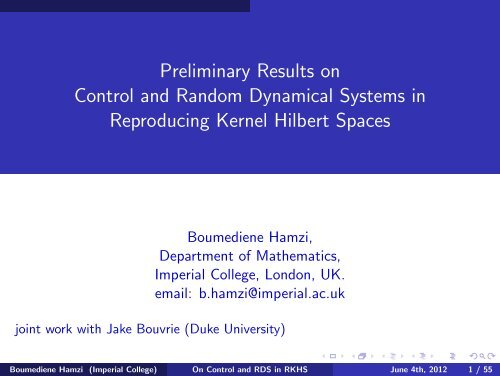
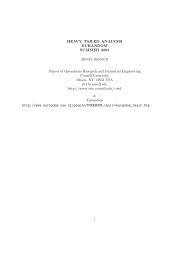
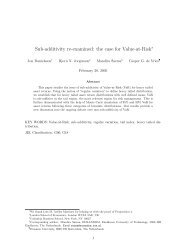
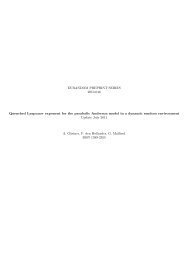
![The Contraction Method on C([0,1]) and Donsker's ... - Eurandom](https://img.yumpu.com/19554492/1/190x143/the-contraction-method-on-c01-and-donskers-eurandom.jpg?quality=85)
